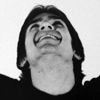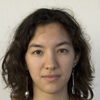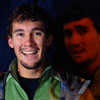Table of Contents
Projects
Projects
This page showcases the student projects, including both the photographs themselves and images of the completed installation. Photographs and statements are courtesy of the students named and are used with permission; installation photos are courtesy of the course teaching assistants, Adele Phillips and Sadia Shirazi.
The assignment was to develop a body of work that responds to the theme of Brain and Cognitive Science. Students were introduced to the theme through the readings, as well as the site visits and further discussions in the classroom. Part of the assignment was also to find a meaningful way of installing their project on site. Students could freely choose the medium (analog or digital photography, installation, etc.) and location for their project.
Installation Posters (PDF)
I began my project by attempting to shoot images of perspective or planar views in such a way that distorted one's normal viewpoint. After trying different experimental methods, I decided that overlaying negatives was the best way to achieve the discomforting effect on a viewer that I was trying to capture. My intent was to cause people to question the image in front of them and how it related to the world with which they are familiar. How do we react to the visual construction of plane and perspective? Can an image of something we see everyday cause internal disturbance simply by changing our viewpoint?
These images focus on how we interpolate a body (especially a human body) into images that we see, even if a body is not present.
I remember most events in my life as clear, colorful photographs. However, faces by themselves blend in and out of darkness, merely offering an outline or a sketch – never quite the whole person. Even more obscure are memories from a specific period in my childhood, age four to seven, which interrupt an otherwise continuous montage of my life. During that time my family had moved to Khabarovsk, Russia, where, from what my parents told me, I fell unpleasantly sick very often. I vividly recall the day my family left Russia for good, and I vowed never to speak another word of Russian, which I had spoken fluently until that moment.
These images feature both recent self portraits and photos from the period of my childhood of which I have no memory.
In the brain, signals are passed from neuron to neuron via chemical synapses. Light, like the thousands of neurotransmitters involved in synapses, is volatile and contagious. Light is ready to relay a blazing message, glow with a bright idea, or smolder as a withering thought. This semester, I sought to capture the beauty of light in a way that would mimic the action that occurs within and the structure that defines neurons.
One crucial element that differentiates how people perceive the world is the disparity between the lenses they look through. Lenses such as glasses, contacts, microscopes and magnifying lenses often alter the way reality is perceived. Moreover, lenses even exist in our eyes and in the camera, dominating human perception.
In my personal life, I tend toward individual activities that allow me to escape and think for a while. I also find myself quite often in natural settings, which can be very conducive to thought and meditation. This project encourages reflection by immersing the viewer in the isolation of nature. The contrast, the lines in the trees, and the patterns in the grass are meant to absorb the viewer's attention, and in contemplating these forms, have the same relaxing, thought-promoting effect as nature itself.
This project seeks to use the photographic medium to create a sensation of tension within the viewer in a number of different ways.
What is reality? How do we tell the difference between what is real and what is an illusion? I want to explore how we feel when we think something is real and then discover that it was not reality as we thought it was? I want to contradict the general assumption that photographs are strictly real, or that they show reality exactly as it is. These pictures are designed to confuse the brain, to show something in such a way that we first perceive it as one thing, and then discover that it is in fact not exactly as we thought it was. It is my hope that as people walk through the BCS building, they will first see my photos and assume that they are all real, but eventually they will stop to read the project description and once they do, they'll begin to wonder about the actual content of all the images. It is this uncertainty that I hope to foster with my project.
This project explores and manipulates our perception of ordinary, everyday passages throughout MIT. Every image is composed of two or more photographs, one of the hallway itself and another that changes and enhances the way we view that hallway. Some of the photographs expose what goes on behind the closed doors of the passageway while others merge two different spaces, letting the viewer reach the realization that two seemingly distinct spaces may be combined to change the way each individual space is perceived.
Photo booths are places of self expression. They are places to cathartically release emotion. Uniquely, unlike a pure self-portrait, they offer to capture a moment more fully with its format of 4 timed photos, allowing multiple poses or expressions in a time-lapse.
Photo Booth seeks to break down this moment even further by separating the emotions into two vector sums. Seeking to stay true to the original sense of timed self-exploration, the piece moves from a pure portrait through more extreme separations.
Read more: (PDF)




















































